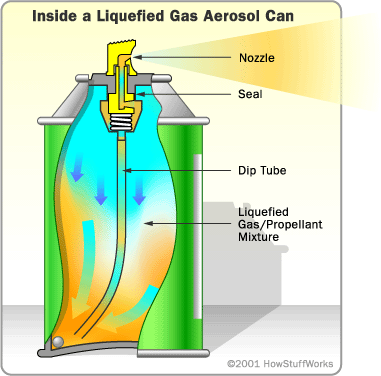
I recently used up the last bit of my spray sunscreen. I remembered reading that my local recycling facility doesn't accept aerosol bottles so I knew that I couldn’t just toss it into the bin. As I was beginning my search for how to dispose of this kind of bottle, I realized that I didn’t really understand aerosol bottles and why curbside recycling programs don't accept them. They appear to be made of metal so one could easily assume they would be recyclable. To start, here is a brief overview of what aerosol cans are and how they work.
Aerosol bottles are usually metal but can also be plastic. They are designed to dispense liquid contents as a mist or foam. Most aerosol bottles have a shell, a valve, a “dip tube” that extends from the valve to the liquid product, and a liquefied-gas propellant under pressure. The liquid product is generally mixed with the propellant. When the valve is opened, this solution moves up the dip tube and out the valve. The propellant vaporizes as it is released into the atmosphere, dispersing the product in the form of fine particles. Personally, I’m visual person so here is a graphic I found that helps show the inner workings of an aerosol bottle.
Until 1978 when it was banned for potentially harmful environmental effects, Chlorofluorocarbons, often called Freons, were the main type of propellants used in aerosol-spray bottles. Today manufacturers use hydro carbons and carbon dioxide in most aerosol spray bottles. If bottles are not completely emptied out before disposal they can explode when being compacted. Hence, why recycling companies don't accept them.
Before disposing of an aerosol bottle, make sure to use up all that you can by pressing the nozzle of the bottle. DO NOT puncture or try to open the can to empty out the contents as this can cause it to explode. Depending on the contents of the bottle, such as paint, you may have to dispose of the empty aerosol can at your local household hazardous waste disposal facility rather than throwing it into the trash.
I was unable to find anywhere to recycle aerosol cans but I am really glad to have learned more about this type of packaging. Knowing that this type of container is destined for the landfill, in the future I will try to avoid this type of packaging.
I tend to use aerosol bottles for three things: sunscreen, cooking spray, and hair sprays. I was easily able to find aerosol bottle free alternatives for each one of them.
Sunscreen: While spray sunscreen is quicker and easier to apply, cream sun screen provides better coverage. I learned this the hard way on my first day at the beach in Hawaii last summer when I got roasted after applying only a spray sunscreen. Raw Elements sunscreen is reef safe and comes in an aluminum tin that can be recycled.

Cooking Spray: There are containers that use air pressure produced by hand-operated pumps instead of a propellant. If you really want the effect that an aerosol bottle provides perhaps check out his type of container for spraying cooking oils. You could also just brush your pots and pans with a little oil.

Hairspray: I don’t use hairspray a whole lot, but when I do I have been using aerosol hair spray. I have fine hair and the aerosol formulas seem to be more lightweight. Moving forward I am going to try a lightweight hair spray in a pump bottle. I will likely start with this one. If I am unable to find a pump bottle hairspray that works as well as the aerosol sprays then I’ll consider looking for an air pressure propellant bottle to use for my hair sprays as well.
What do you use aerosol bottles for? Can it be avoided?


Comments